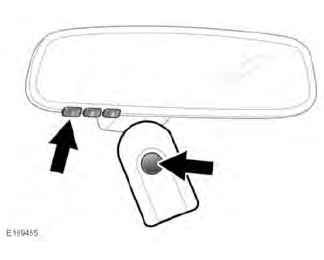Land Rover Discovery: Radio frequency transceiver
In some countries, the Radio Frequency (RF) transceiver is also known as the HomeLink Universal Transceiver.
The RF transceiver is located in the rear-view mirror. It can be programmed to transmit the signals of up to 3 different hand-held transmitters. These can be used to operate garage doors, entry gates, home lighting, security systems, or other RF-operated remote devices.
- Do not use the RF transceiver with any garage door opener that lacks the safety stop and reverse feature, as required by safety standards.
- When programming the RF transceiver to a garage door opener or entry gate, make sure that the area is clear of people and objects. This will prevent potential harm or damage, as the gate or garage door will activate during programming.
This device may suffer from interference, if operated in the vicinity of a mobile or fixed station transmitter. This interference is likely to affect the hand-held transmitter, as well as the RF transceiver.
For further information
BEFORE PROGRAMMING
When programming a remote device that may require you to press and re-press the hand-held transmitter, unplug the device during the programming process, to prevent possible motor failure.
For best results, fit a new battery to the hand-held transmitter before programming. If the remote device's receiver is equipped with an antenna, make sure the antenna is extended.
PROGRAMMING

To program the RF transceiver:
- Switch the vehicle's ignition on.
- Position the hand-held transmitter 25 to 75 mm from the rear-view mirror.
- Simultaneously press and hold the memory button on the hand-held transmitter, and the desired memory button on the RF transceiver. An indicator LED, located on the left side of the mirror, will start flashing slowly.
- When the LED starts flashing quickly, release both buttons.
To operate the remote device, press and hold the programmed memory button on the RF transceiver for 2 seconds. If the LED illuminates continuously, the RF transceiver has been programmed successfully, and the remote device will operate.
Note: You may need to press the button on the RF transceiver up to 3 times.
If the remote device does not operate, and the LED flashes quickly, further programming will be required.
These additional programming steps may require assistance from another person.
- Locate the smart/learn program button on the remote device you wish to program.
Note: The name and location of this button may vary, depending on the manufacturer of the remote device.
- Press and release the smart/learn program button, and within 30 seconds, press and hold the desired memory button on the RF transceiver for 2 seconds.
Note: You may need to press and hold the memory button on the RF transceiver for 2 seconds, a further 2 times.
Note: Some entry gate systems require you to cycle (press and re-press) the hand-held transmitter every 2 seconds during programming. If this is the case, continue to press and hold the memory button on the RF transceiver until the LED flashes quickly.
The RF transceiver should now be programmed. Repeat the programming steps, if you wish to add further remote devices to the RF transceiver.
To operate a programmed remote device, press and hold the relevant memory button on the transceiver. Release the button when the device starts operating.

